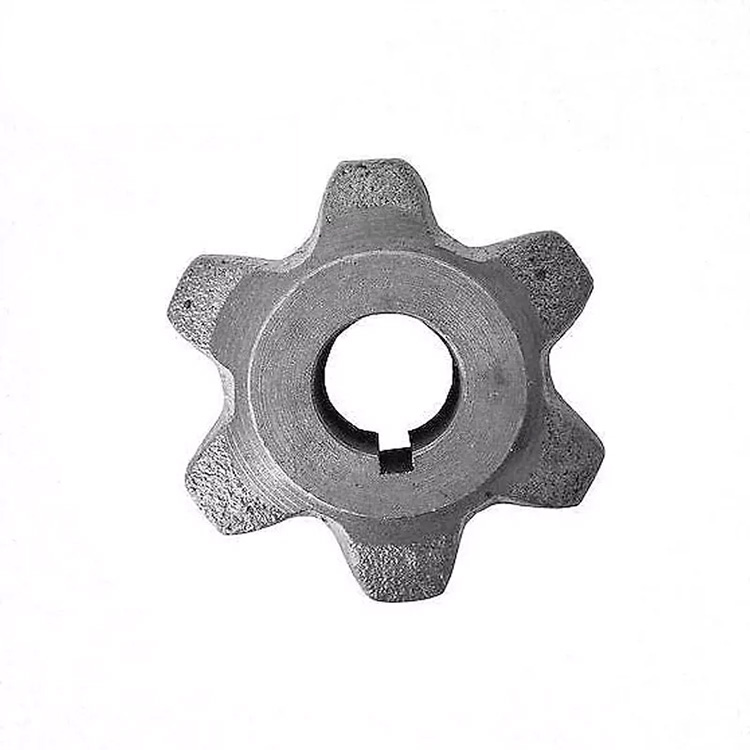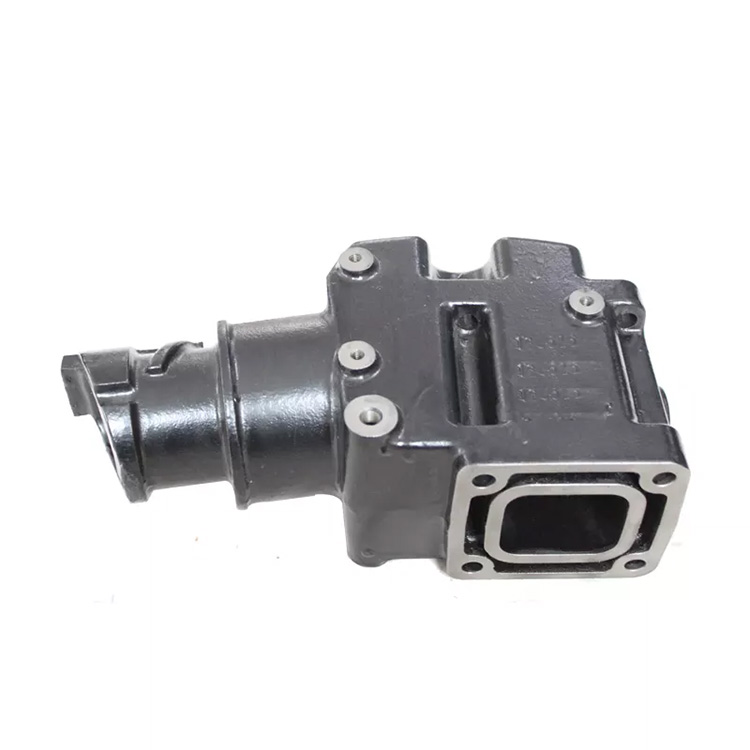Dandong Iron Casting Group owns automatic shell casting production line,our production process as follow:
Shell Casting
The process of casting permits a manufacturer to create an object by pouring molten metal (or other liquids) into a mold and allowing the material to harden. The reformed material assumes the shape of the mold cavity. Casting has produced metal items for thousands of years. Today, shell casting (with the assistance of shell molding) has become a widespread casting technology.
About Shell Casting
Shell casting differs from some other forms of casting because this process relies upon the creation of a series of expendable “shell” molds. Each shell mold will only cast a single item. However, the low cost and comparative ease of creating shell molds enables some manufacturers to automate shell casting in high volume production facilities.
The Shell Casting Process
The shell casting process falls naturally into three phases: (1) generating permanent metal patterns,(2) creating a series of expendable shell molds, and (3) casting metal components from the shell molds. Some metal parts manufacturers automate the final two steps during high volume production runs.
Generating Permanent Metal Patterns
Manufacturers usually begin the shell casting process by producing permanent metal patterns for clients from iron, steel or aluminum. The two-piece patterns will form the complete shape of a desired metal part. They incorporate a gating system within the pattern. The custom production of the metal patterns constitutes a significant expense; however, after making this investment, a manufacturer can anticipate re-using the patterns extensively to generate expendable shell molds.
Shell Molding
The second phase of shell casting involves the creation of an expendable “shell” mold formed from sand and resin. This process differs from sand casting, since the mold will accurately reflect the shape of the two-part metal patterns. Typically, the manufacturer heats the pattern, coats it with a lubricant, and places it securely in a “dump box” filled with loose sand mixed with resin. Turning the dump box causes the mixture to adhere to both section of the lubricated hot metal pattern. The manufacturer then places both coated pattern sections into an oven to harden the shells. Upon removal from the oven, the pattern separates from the shell to return to the dump box, leaving behind an expendable two-part sand-and-resin mold.
Casting Metal Components
The manufacturer securely fastens the two sections of the shell together before placing them inside a metal flask filled with backing material. The manufacturer pours molten metal inside the shell mold. It cools gradually inside the mold, forming a new metal part in the shape of the original pattern. After cooling, the manufacturer opens the flask, breaks the remnants of the shell mold and retrieves the metal part to perform finishing operations, such as trimming away excess metal from the juncture of the two mold sections.

Materials And Applications
Both the comparatively simple materials utilized during shell molding and shell casting and the numerous applications for this casting method have contributed to its popularity:
Materials
Shell casting works effectively with a variety of metals and metal alloys. For example, manufacturers today utilize this form of casting to produce both ferrous and non-ferrous components. Typical raw materials include aluminum, nickel and copper alloys, as well as cast iron, steel alloys and even carbon steel.
In addition to the raw materials, a manufacturer must create a metal pattern to permit the formation of a series of expendable shell molds. Generally, the pattern consists of two individual sections. Iron or steel patterns will furnish longer utility. However, aluminum patterns may offer cost savings benefits. The manufacturing process also requires the availability of resin and sand (or other materials forming the “shell”), as well as lubricants, backing material, a furnace or other heating source, an oven, a molten metal pouring system and a strong flask to hold the shell mold during the casting process. This form of casting today potentially occurs in both high tech, automated facilities and relatively low tech environments, such as blacksmith shops.
Applications
Modern shell casting offers versatility. Many industries use this form of manufacturing extensively. Today companies employ shell casting to create cylinder heads, valve bodies, connecting rods, cam shafts, lever arms, bushings and gear housings. From automotive and consumer goods to industrial manufacturing, shell molding and shell casting play an important role in production.
Advantages of Shell Casting
Shell casting offers a number of important advantages.
- It permits the creation of very complex, detailed metal components. It offers an excellent way to produce small and medium-sized shapes, especially parts requiring accurate manufacturing.
- This form of casting today may occur in highly automated environments; production does not impose a high demand for labor following the creation of the metal pattern.
- Since shell casting generates intricate parts repetitively, manufacturers utilizing this process may avoid some manufacturing tooling costs required for other production processes. Fourth, depending upon the raw materials employed, shell casting may result in the creation of very attractive exterior surfaces. Parts may require a minimal investment in finishing, for instance.
- Shell casting utilizes raw materials with a high degree of efficiency. Manufacturers who employ this process typically will conserve metals and metal alloys without wasting these assets. As with many other forms of casting, when a work piece fails to meet required specifications, a manufacturer can simply re-melt it and re-use the constituent raw materials.
- Since this casting process lends itself to automation in high volume production environments, it permits companies to generate large quantities of metal parts rapidly. The production of expendable shell molds may occur repetitively. While a manufacturer will eventually need to replace the metal pattern, that cost arises infrequently.
Experience
Dandong Iron Casting Group owns automatic shell casting production line,our production process as follow:
Shell Casting
The process of casting permits a manufacturer to create an object by pouring molten metal (or other liquids) into a mold and allowing the material to harden. The reformed material assumes the shape of the mold cavity. Casting has produced metal items for thousands of years. Today, shell casting (with the assistance of shell molding) has become a widespread casting technology.
About Shell Casting
Shell casting differs from some other forms of casting because this process relies upon the creation of a series of expendable “shell” molds. Each shell mold will only cast a single item. However, the low cost and comparative ease of creating shell molds enables some manufacturers to automate shell casting in high volume production facilities.
The Shell Casting Process
The shell casting process falls naturally into three phases: (1) generating permanent metal patterns,(2) creating a series of expendable shell molds, and (3) casting metal components from the shell molds. Some metal parts manufacturers automate the final two steps during high volume production runs.
Generating Permanent Metal Patterns
Manufacturers usually begin the shell casting process by producing permanent metal patterns for clients from iron, steel or aluminum. The two-piece patterns will form the complete shape of a desired metal part. They incorporate a gating system within the pattern. The custom production of the metal patterns constitutes a significant expense; however, after making this investment, a manufacturer can anticipate re-using the patterns extensively to generate expendable shell molds.
Shell Molding
The second phase of shell casting involves the creation of an expendable “shell” mold formed from sand and resin. This process differs from sand casting, since the mold will accurately reflect the shape of the two-part metal patterns. Typically, the manufacturer heats the pattern, coats it with a lubricant, and places it securely in a “dump box” filled with loose sand mixed with resin. Turning the dump box causes the mixture to adhere to both section of the lubricated hot metal pattern. The manufacturer then places both coated pattern sections into an oven to harden the shells. Upon removal from the oven, the pattern separates from the shell to return to the dump box, leaving behind an expendable two-part sand-and-resin mold.
Casting Metal Components
The manufacturer securely fastens the two sections of the shell together before placing them inside a metal flask filled with backing material. The manufacturer pours molten metal inside the shell mold. It cools gradually inside the mold, forming a new metal part in the shape of the original pattern. After cooling, the manufacturer opens the flask, breaks the remnants of the shell mold and retrieves the metal part to perform finishing operations, such as trimming away excess metal from the juncture of the two mold sections.

Materials And Applications
Both the comparatively simple materials utilized during shell molding and shell casting and the numerous applications for this casting method have contributed to its popularity:
Materials
Shell casting works effectively with a variety of metals and metal alloys. For example, manufacturers today utilize this form of casting to produce both ferrous and non-ferrous components. Typical raw materials include aluminum, nickel and copper alloys, as well as cast iron, steel alloys and even carbon steel.
In addition to the raw materials, a manufacturer must create a metal pattern to permit the formation of a series of expendable shell molds. Generally, the pattern consists of two individual sections. Iron or steel patterns will furnish longer utility. However, aluminum patterns may offer cost savings benefits. The manufacturing process also requires the availability of resin and sand (or other materials forming the “shell”), as well as lubricants, backing material, a furnace or other heating source, an oven, a molten metal pouring system and a strong flask to hold the shell mold during the casting process. This form of casting today potentially occurs in both high tech, automated facilities and relatively low tech environments, such as blacksmith shops.
Applications
Modern shell casting offers versatility. Many industries use this form of manufacturing extensively. Today companies employ shell casting to create cylinder heads, valve bodies, connecting rods, cam shafts, lever arms, bushings and gear housings. From automotive and consumer goods to industrial manufacturing, shell molding and shell casting play an important role in production.
Advantages of Shell Casting
Shell casting offers a number of important advantages.
- It permits the creation of very complex, detailed metal components. It offers an excellent way to produce small and medium-sized shapes, especially parts requiring accurate manufacturing.
- This form of casting today may occur in highly automated environments; production does not impose a high demand for labor following the creation of the metal pattern.
- Since shell casting generates intricate parts repetitively, manufacturers utilizing this process may avoid some manufacturing tooling costs required for other production processes. Fourth, depending upon the raw materials employed, shell casting may result in the creation of very attractive exterior surfaces. Parts may require a minimal investment in finishing, for instance.
- Shell casting utilizes raw materials with a high degree of efficiency. Manufacturers who employ this process typically will conserve metals and metal alloys without wasting these assets. As with many other forms of casting, when a work piece fails to meet required specifications, a manufacturer can simply re-melt it and re-use the constituent raw materials.
- Since this casting process lends itself to automation in high volume production environments, it permits companies to generate large quantities of metal parts rapidly. The production of expendable shell molds may occur repetitively. While a manufacturer will eventually need to replace the metal pattern, that cost arises infrequently.










